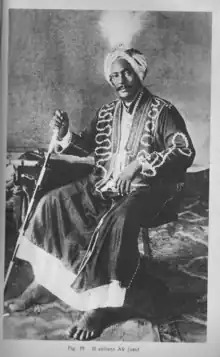| Ali Yusuf Kenadid علي يوسف كينيديد | |||||
|---|---|---|---|---|---|
 Portrait of Ali Yusuf Kenadid | |||||
| Sultan of Hobyo | |||||
| Reign | Early 1900s – 1925 | ||||
| Coronation | 5 October | ||||
| Predecessor | Yusuf Ali Kenadid | ||||
| Successor | Monarchy abolished | ||||
| Died | 1927 Jijiga, Ethiopian Empire[1] | ||||
| |||||
| Father | Yusuf Ali Kenadid | ||||
| Religion | Islam | ||||
Ali Yusuf Kenadid (Somali: Cali Yuusuf Keenadiid, Arabic: علي يوسف كينيديد) was a Somali ruler. He was the second ruler of the Sultanate of Hobyo.
History
Ali Yusuf was born into a Majeerteen Darod family. His father, Sultan Yusuf Ali Kenadid, was the founder of the Sultanate of Hobyo centered in present-day northeastern and central Somalia. The polity was established in the 1870s on territory carved out of the ruling Majeerteen Sultanate (Migiurtinia).[2] Ali Yusuf's brother, Osman Yusuf Kenadid, would go on to invent the Osmanya writing script for the Somali language.[3]
In an attempt to advance his own expansionist objectives, Kenadid père in late 1888 entered into a treaty with the Italians, making his realm an Italian protectorate.[4] The terms of the agreement specified that Italy was to steer clear of any interference in the sultanate's administration.[5]
However, the relationship between Hobyo and Italy soured when the elder Kenadid refused the Italians' proposal to allow a British contingent of troops to disembark in his Sultanate so that they might then pursue their battle against Mohammed Abdullah Hassan's Dervish forces.[4] Ali Yusuf and his father were then exiled to Eritrea.
See also
References
- ↑ Dualeh, Hussein Ali (2002). "Search for a New Somali Identity".
- ↑ Helen Chapin Metz, ed., Somalia: a country study, (The Division: 1993), p.10.
- ↑ Diringer, David (1968). The Alphabet: A Key to the History of Mankind, Volume 1. Funk & Wagnalls. pp. 235–236. ISBN 1452299374. Retrieved 14 December 2014.
- 1 2 The Majeerteen Sultanates
- ↑ Issa-Salwe, Abdisalam M. (1996). The Collapse of the Somali State: The Impact of the Colonial Legacy. London: Haan Associates. pp. 34–35. ISBN 187420991X.